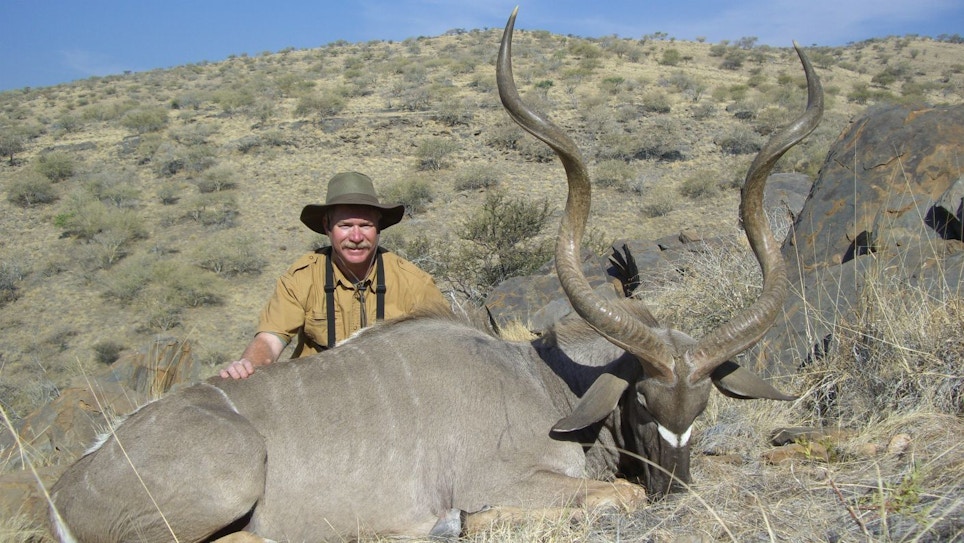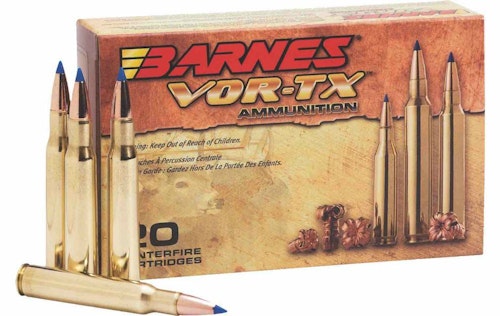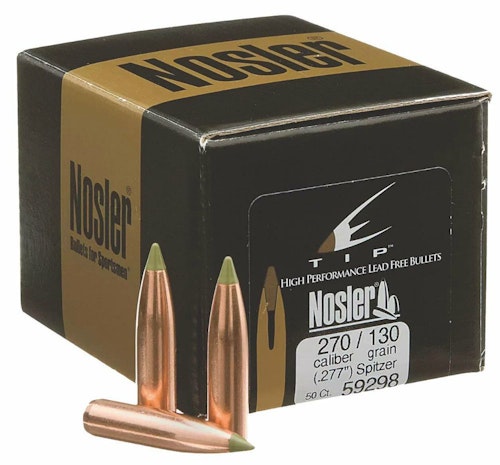
The author used Barnes TSX non-toxic rifle bullets on a Namibian plains game safari and cleanly took kudu (above) as well as eight other species of plains game.
Any discussion of non-toxic rifle bullets is likely to result in an argument. On one side, you often have those who believe using lead for any kind of hunting projectile is always wrong, and those who use lead ammo must hate the environment. On the other end of the spectrum are those who refuse to consider shooting non-toxic bullets because they don’t want the “environmental whackos” telling them what kind of ammunition they can use.
With the increasing environmental concerns about lead ammo, it’s a discussion that likely will occur more often in the future. Now, I don’t personally think shooting lead rifle bullets will poison me when I eat venison or pollute the areas where I hunt. After all, I shoot only a handful of bullets per year at game. However, I’m open-minded enough to at least consider that maybe putting more lead into my game, the ground and the environment might not be necessary if non-toxic alternatives are plentiful, affordable and reliable.
When talking about non-toxic rifle bullets, we’re basically referring to ammunition that doesn’t use lead in the rifle projectile. While a number of different lead alternatives have emerged for shotshells, in most cases for rifle ammunition, copper is the preferred substitute.
A Trump administration change has put mandatory use of non-toxic rifle bullets on the backburner for now, but California mandates non-lead ammo for all hunting, and the day will likely come when it’s required on most federal lands. When that happens, I truly don’t believe big game hunters are going to be disappointed with the performance they get out of modern non-lead rifle ammo.
On the downside, non-toxic rifle bullets sometimes costs a little more than traditional lead ammunition. But when compared to premium rifle ammo, the difference is negligible. Because ammunition is typically a small part of big game hunting expenses, using non-lead bullets won’t significantly increase the cost of a hunt.
And what if non-toxic ammo was just as good — maybe even better — than lead ammunition? Many copper bullets can be made to expand just like lead, reaching an expanded diameter about double their normal size. They also retain a very high percentage of their weight, giving them the ability to drive deep into large game animals that need a little more punch.
I used Barnes TSX (Triple Shock X) bullets on a Namibian plains game safari nearly a decade ago, not because I had to, but because I had heard good things about its performance (see photo above). I cleanly took nine species of plains game, including two kudus, with the TSX and doubt any lead bullet would have outperformed it.
Let’s take a brief look at three non-toxic rifle bullets that would be good alternatives to lead projectiles for hunters considering making the switch.
Barnes
Barnes VOR-TX Premium Hunting Ammunition is a line of non-toxic ammo that includes the TSX I used with great success on the aforementioned African plains game trip. The Barnes TSX was offered in a Federal Premium loading, and it completely changed my mind about the use of non-lead bullets on big, hard-to-kill game animals. The line includes the TSX, the tipped TSX and the TSX-FN.
With each model made of all copper, all of the bullets in the VOR-TX line are touted by the company to offer double-diameter expansion, maximum weight retention and exceptional accuracy. The result is maximum tissue and bone destruction, pass-through penetration and devastating energy transfer for clean kills on big game animals.
Barnes offers these bullets in calibers to appeal to all types of hunters, from small game all the way up to gigantic species. It has 41 cartridge choices in the lineup, ranging from .223 Rem. all the way up to .450 Bushmaster.
The TSX is a hollowpoint bullet that has been used for more than a decade by serious big game hunters. I’ve shot it in both .270 Win. and .300 Win. Mag. and had success with each. The tipped TSX is basically the same bullet with a streamlined polymer tip that boosts the ballistic coefficient and improves long-range ballistics. The TSX-FN is a flat-nosed version of the bullet. In all the TSX bullets, multiple grooves in the bullet’s shank reduce pressure and improve accuracy. Barnes all-copper bullets open instantly on contact, and the nose peels back into four sharp-edged copper petals for a quick, humane kill.
Contact: www.barnesbullets.com
Nosler
While Nosler is a fairly new name in the manufactured ammo arena, I’ve shot Nosler ammunition in several calibers over the past few years and have been very pleased with it. The company’s non-toxic rifle offering is the E-Tip.
The folks at Nosler say that upon impact, Nosler’s exclusive E² Cavity (Energy Expansion Cavity) allows for immediate and uniform expansion, yet the bullet retains 95% of its weight for improved penetration. In fact, they say the E² Cavity provides excellent stopping power and peerless penetration over a broad spectrum of impact velocities.
The E-Tip bullets have an easily recognized OD green polymer tip, which is designed to initiate expansion when the bullet hits a big-game animal. The boat-tail configuration of the bullet combines with the streamlined polymer tip for extreme long-range performance and for easier loading by hand loaders.
Nosler E-Tip bullets are also available as raw bullets for hand loaders and in some Winchester factory loadings. For hand loaders, 15 different cartridge/weight combinations are available. Factory E-Tip cartridges from Nosler are available in more than 30 different loads.
While I’ve never shot the Nosler E-Tip, I have talked to several other hunters who have and were very satisfied with their results.
Contact: www.nosler.com
Remington
When there’s a developing trend in ammunition, Remington is sure to be involved. Big Green introduced its Premier Copper Solid line of non-toxic centerfire rifle ammunition back in 2009 with an initial offering of eight different cartridges.
Premier Copper Solid rifle ammunition features a precision-engineered, polymer-tipped copper matrix bullet designed to provide a combination of extreme accuracy with devastating penetration and maximum weight retention, making it great for all big game species. Remington offers the ammunition, which meets all requirements for lead-free hunting ammunition, in most of today’s popular calibers and grain weights.
The polymer-tipped nose and boat-tail base produce a high ballistic coefficient that flattens trajectory and preserves downrange energy. Plus, Premier Copper Solid ammunition is specifically constructed under a proprietary manufacturing process to deliver controlled expansion and nearly 90% weight retention. In other words, it’s not going to give up much in performance to older lead loads that you might currently be shooting. I’ve shot a few Oklahoma whitetails with the bullet chambered in .270 Win. and found them to be just as dead when I approached as were those shot with conventional lead bullets.
Remington says another attribute of the non-toxic rifle bullet is its ability to expand over a wide variety of impact velocities, something not all copper bullets are capable of achieving. This is important for hunters who are in an area where they might shoot their game very close or at great distances.
Contact: www.remington.com








